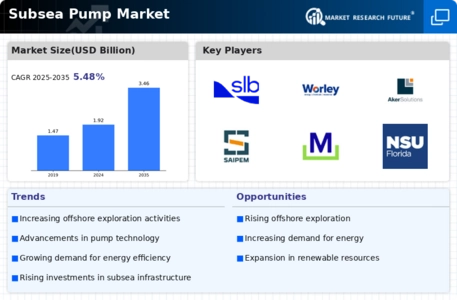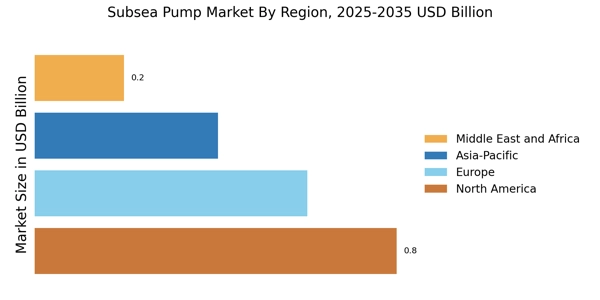Advancements in Subsea Pump Technology
Technological advancements are a key driver for the Subsea Pump Market, as innovations in design and materials enhance performance and reliability. Recent developments include the integration of smart technologies, such as sensors and automation, which allow for real-time monitoring and control of subsea pumps. These advancements not only improve operational efficiency but also reduce maintenance costs, making subsea operations more economically viable. The market is witnessing a shift towards more compact and energy-efficient pump designs, which are expected to dominate the industry in the coming years. As operators seek to leverage these technologies, the Subsea Pump Market is likely to benefit from increased investment in research and development.
Regulatory Support for Subsea Operations
Regulatory frameworks are increasingly supporting the expansion of subsea operations, which in turn drives the Subsea Pump Market. Governments are implementing policies that encourage investment in offshore exploration and production, often providing incentives for companies that adopt environmentally friendly practices. This regulatory support is crucial as it fosters a conducive environment for technological innovation and investment in subsea infrastructure. As more countries recognize the economic potential of their offshore resources, the demand for subsea pumps is expected to rise. The Subsea Pump Market is likely to benefit from these favorable regulations, which promote sustainable and efficient extraction methods.
Growing Focus on Renewable Energy Sources
The Subsea Pump Market is also being shaped by the growing focus on renewable energy sources, particularly in the context of offshore wind farms. As the energy landscape evolves, there is a rising need for subsea pumping solutions that can support the installation and maintenance of underwater infrastructure for renewable projects. The integration of subsea pumps in these applications can enhance the efficiency of energy transmission and storage systems. With the offshore renewable energy sector projected to grow significantly, the Subsea Pump Market stands to gain from this transition, as companies seek to develop sustainable solutions that align with global energy goals.
Increasing Offshore Oil and Gas Exploration
The Subsea Pump Market is experiencing a surge in demand due to the increasing exploration activities in offshore oil and gas fields. As conventional onshore reserves deplete, companies are turning to subsea resources, which are often located in deeper waters. This shift necessitates advanced subsea pumping solutions to efficiently extract hydrocarbons from these challenging environments. According to recent estimates, offshore oil production is projected to grow by approximately 5% annually, driving the need for innovative subsea pumping technologies. The Subsea Pump Market is thus poised for growth as operators seek reliable and efficient solutions to meet their production targets.
Rising Demand for Enhanced Oil Recovery Techniques
The Subsea Pump Market is significantly influenced by the rising demand for enhanced oil recovery (EOR) techniques. As oil prices stabilize, operators are increasingly investing in technologies that maximize extraction from existing fields. Subsea pumps play a crucial role in EOR by facilitating the injection of water, gas, or chemicals into reservoirs, thereby improving recovery rates. The market for EOR is expected to expand, with estimates suggesting a compound annual growth rate of around 6% over the next five years. This trend indicates a robust opportunity for the Subsea Pump Market, as companies seek to optimize their production processes and extend the life of mature fields.


















Leave a Comment